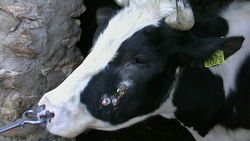Mandibular Osteomyelitis
Jump to navigation
Jump to search
| This article is still under construction. |
Description
Signalment
The condition affects cattle 2-5 yrs old, those that are exposed to sharp objects whilst feeding and when teeth are erupting.
Diagnosis
The condition is easily diagnosed on clinical signs and can be confirmed by crushing and staining the yellow granules expressed with the pus from skin leisions to reveal gram-positive filamentous rods.
Clinical signs
Pathology
Treatment
Prognosis
References
- Andrews, A.H, Blowey, R.W, Boyd, H and Eddy, R.G. (2004) Bovine Medicine (Second edition), Blackwell Publishing
- Merck & Co (2008) The Merck Veterinary Manual (Eighth Edition) Merial
Clinical
- Seen mainly in cattle and exotics caused by Actinomyces bovis producing osteomyelitis of mandible.
- Mostly young animals.
- Will not heal without treatment and jaw enlarges until animal cannot eat.
Pathogenesis
- Starts as alveolar periostitis of lower cheek teeth, due to ingestion of poor coarse roughage e.g. straw or hay with lots of thistles.
- Slowly enlarging mandible (occasionally maxilla) due to granulomatous inflammation producing much fibrous tissue.
- No real pus formation but "sulphur granules" in middle of lesion.
- Organism causes "pyogenic granuloma."
- Can grow to enormous size (e.g. size of grapefruit) and whole of mandible is blown apart by multiple foci of infection.
Also see:Actinobacillosis - "Wooden Tongue" (Courtesy of Alun Williams (RVC))
Pathology
3 major features:
- Inflammatory removal of bone. As cortex of bone is pushed out by central inflammation produces thinning of bone cortex with proliferation of new periosteal bone. The centre of the mandible is eroded forming a honeycomb-like bone. Eventually will erode through bone producing granulomatous lesion on bottom of mandible and eventually eroding through skin.
- Granuloma with micro abscess's in centre with greenish / yellow granules in middle of pus. These granules known as "sulphur bodies". Sulphur body is a colony of tangled mass of Actinomyces filaments. This is surrounded by neutrophils and macrophages forming a pyogenic granuloma.
- Masses of fibrous tissue surround the granuloma and fill the spaces where bone has been destroyed.
- May extend to muscles, especially masseters, from osteomyelitis
- Histologically:
- Caseous or suppurative centres of lesions
- Epithelioid and giant cells at periphery
- 'Sulfa granules' at centre - gram-positive branching rods
| Also known as: | Lumpy jaw |
